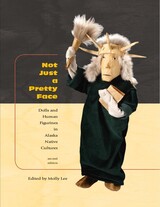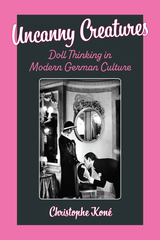2 books about Dolls

Not Just a Pretty Face
Dolls and Human Figurines in Alaska Native Cultures
Molly Lee
University of Alaska Press, 2006
Now in a full-color second edition, Not Just a Pretty Face is an engaging exploration of the role of dolls and doll making in Alaska Native cultures. From ancient ivory carvings to the thriving tourist market, dolls and human figurines have played integral parts in the ritual, economic, and social lives of Native Alaskans. Dolls served as children’s playthings, represented absent community members at ceremonies, and predicted the movements of game animals for shamans. Not Just a Pretty Face surveys these and other uses of dolls and figurines, illustrating in beautiful color photographs the diversity of the doll-making tradition in Eskimo, Athabaskan, and Northwest Coast Native communities.
Authors explore the ethnographic literature, twentieth-century oral histories, and photographic documentation of dolls and the doll-making process. Contemporary doll makers explain, in their own words, how they learned to make dolls and what doll making means to them. The second edition features a photo essay on Rosalie Paniyak of Chevak, one of the most influential doll makers in Alaska today.
Not Just a Pretty Face provides a panoramic view of an ancient tradition and situates the art of doll making within a contemporary context. Scholarly, yet accessible, Not Just a Pretty Face is a lively contribution to the literature on dolls, anthropology, and Native studies.
Authors explore the ethnographic literature, twentieth-century oral histories, and photographic documentation of dolls and the doll-making process. Contemporary doll makers explain, in their own words, how they learned to make dolls and what doll making means to them. The second edition features a photo essay on Rosalie Paniyak of Chevak, one of the most influential doll makers in Alaska today.
Not Just a Pretty Face provides a panoramic view of an ancient tradition and situates the art of doll making within a contemporary context. Scholarly, yet accessible, Not Just a Pretty Face is a lively contribution to the literature on dolls, anthropology, and Native studies.
[more]

Uncanny Creatures
Doll Thinking in Modern German Culture
Christophe Koné
University of Michigan Press, 2024
Germany held a monopoly on the manufacture and export of bisque toy dolls in Europe before WWI. Yet, dolls’ omnipresence in the material, visual, and literary culture of the modern German-speaking world has so far not been properly addressed. In demonstrating this cultural affinity for dolls, Christophe Koné draws upon a range of stories and seminal essays on dolls, as well as toys, sculptures, paintings, and photographs. He examines how E.T.A. Hoffmann’s romantic tale The Sandman (1815) has been a major source of inspiration for German-speaking doll makers because of how it centers imagination and inventiveness. Using Hoffmann’s tale as an early example of an amalgam between doll thinking and making in German culture, Koné shows how it initiated a genealogy of doll thinkers (Freud & Jentsch), writers (Rilke), painters (Kokoschka), photographers (Bellmer), and makers (Pritzel).
Uncanny Creatures then explores how this unusual interest in human-like figures continues a long tradition of thought devoted to conceptualizing “things,” from Immanuel Kant’s theory of the thing-in-itself to Martin Heidegger’s lecture on the thing, and Eduard Mörike or Rainer Maria Rilke’s thing-poems. Because dolls occupy a liminal space—not quite things and more than mere objects—they appear as uncanny creatures which have held a fascination for writers, thinkers, and artists alike. Uncanny Creatures moves past the Freudian discourse of fetishism to propose a new reading of doll artifacts in German culture centered on their ability to evoke a feeling of uncertainty and unsettlement in the viewer.
Uncanny Creatures then explores how this unusual interest in human-like figures continues a long tradition of thought devoted to conceptualizing “things,” from Immanuel Kant’s theory of the thing-in-itself to Martin Heidegger’s lecture on the thing, and Eduard Mörike or Rainer Maria Rilke’s thing-poems. Because dolls occupy a liminal space—not quite things and more than mere objects—they appear as uncanny creatures which have held a fascination for writers, thinkers, and artists alike. Uncanny Creatures moves past the Freudian discourse of fetishism to propose a new reading of doll artifacts in German culture centered on their ability to evoke a feeling of uncertainty and unsettlement in the viewer.
[more]
READERS
Browse our collection.
PUBLISHERS
See BiblioVault's publisher services.
STUDENT SERVICES
Files for college accessibility offices.
UChicago Accessibility Resources
home | accessibility | search | about | contact us
BiblioVault ® 2001 - 2024
The University of Chicago Press









